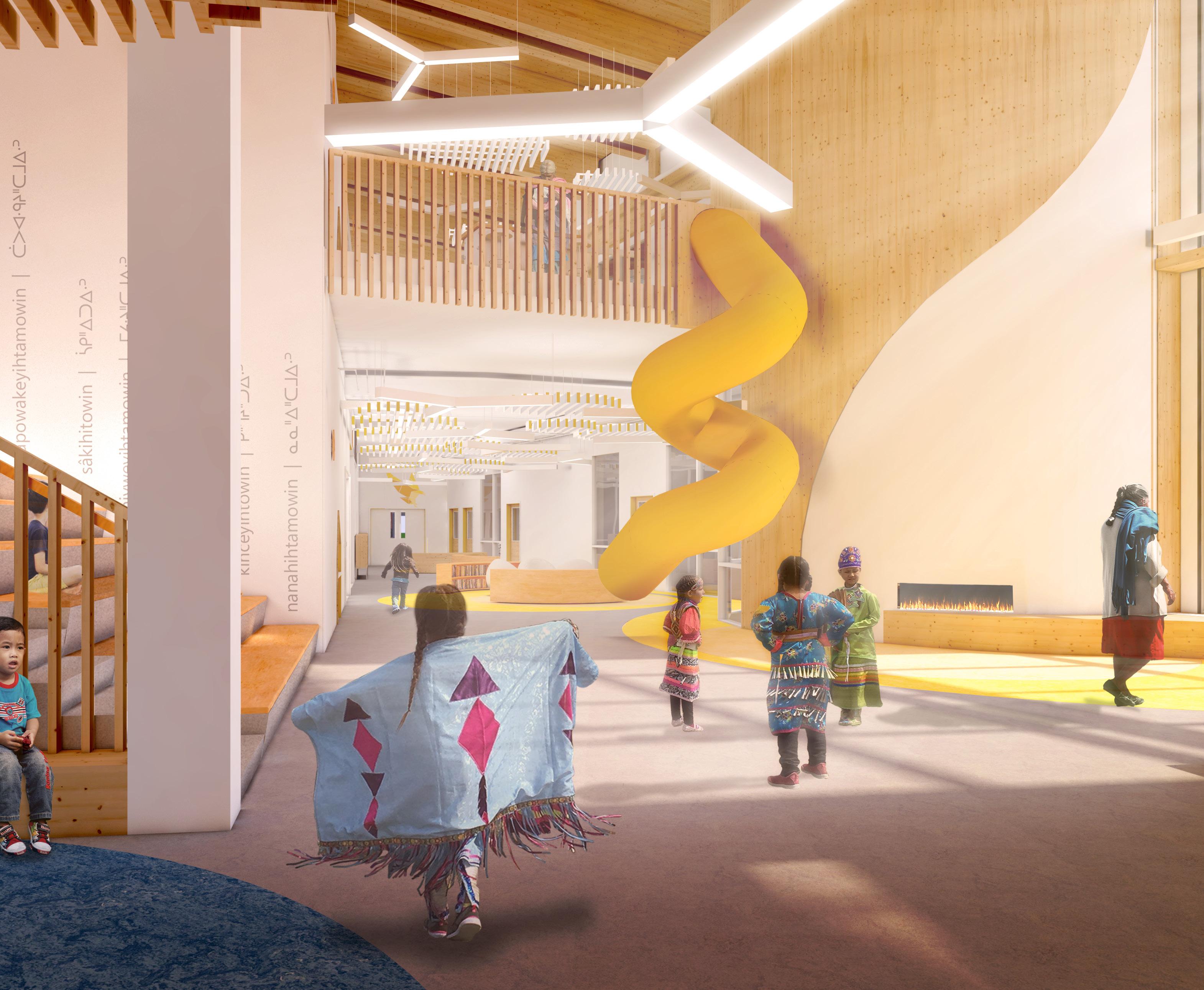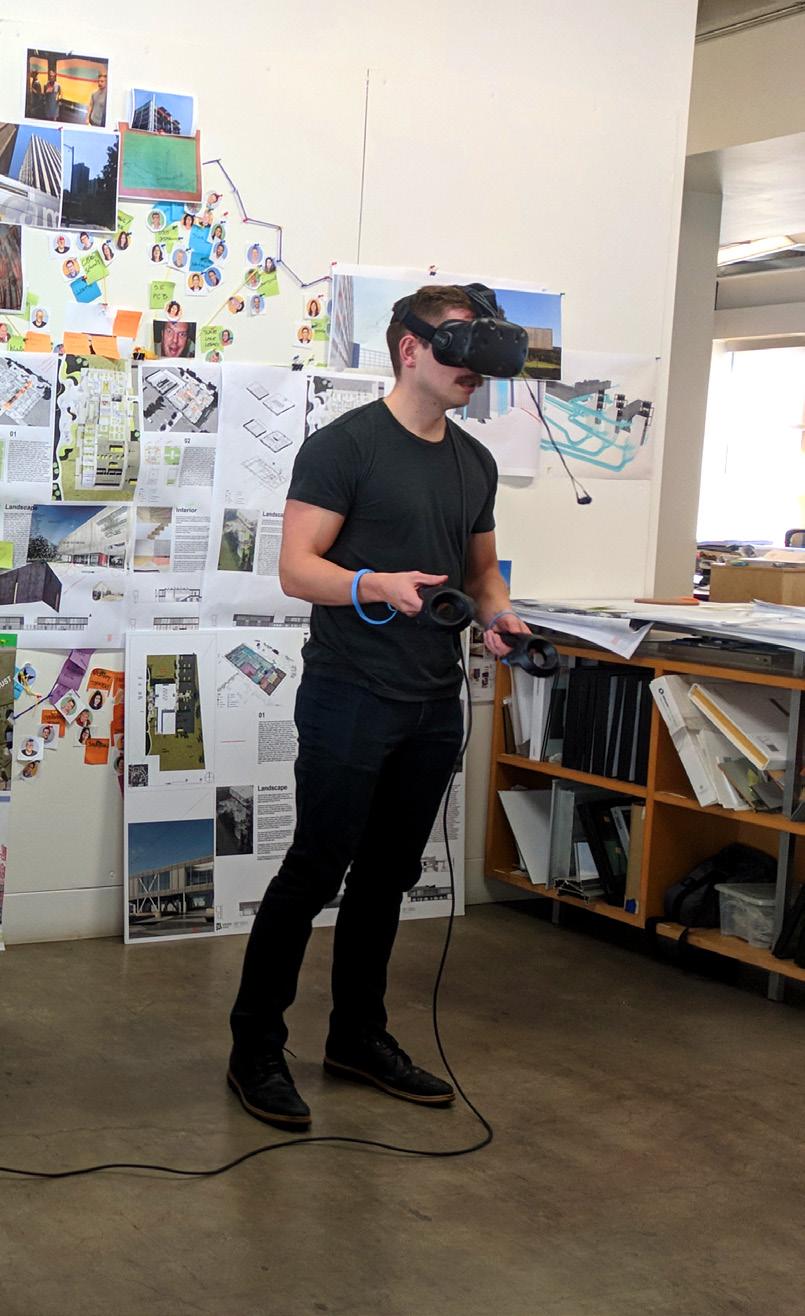
5 minute read
Getting Real
Virtual Reality as communication, participation, education
By Safira Lakhani

Virtual Reality was used to allow the leadership of Saddle Lake Elementary School to move through the school, long before construction began.
Manasc Isaac Architects
The impact of the built environment is profound on all levels of the human experience. It consciously and unconsciously shapes and informs the way we think, speak, and behave, influencing all senses of the body. This intersection of architecture and sensory perception is known as phenomenology. At its core is the simple assertion that the built environment is experienced by engaging the body through its multiple senses.
- juhani pallasmaa
Conventional design processes shift our holistic and multi-sensory experience of architecture to a single, ocular understanding of space. Although the built environment is experienced in three or more dimensions, the design process has traditionally been restricted to two-dimensional representations experienced solely through the sense of sight. Drawings, including plans, sections, elevations, and even three-dimensional visualisations such as perspective sketches or computer models, are flattened onto two-dimensional viewing planes like computer screens or paper. These flat depictions turn the design process into a passive visual manipulation: they provide a visual description of a spatial condition, rather than direct access to it.
The reliance on sight above all other senses during the design process commonly results in design that privileges aesthetics over understanding of how a space may actually be experienced. While designers may be able to fully imagine the experience, light, texture, color and materiality of a given space, there is a very limited ability to share that imagined reality.
VR as communication
Virtual Reality (VR) technology offers a means of bridging the gap between architecture’s design process and people who would like to “pilot” these spaces that are created. Allowing many people to experience that which does not yet exist, VR is spatial, interactive, and occurs in real-time. Although it does not cater to all of the human senses, it offers a new level of experience and immersion, and operates as an extension of human perception. VR allows us to inhabit a simulated environment to access a spatial awareness and sense of scale that is not present in two-dimensional mediums. By moving through this virtual environment, many people are able to develop a sense of embodied cognition, understanding the space in relation to the movement of bodies through that space. Using VR, dimensions, proportions, and design intent can be made manifest without abstraction or annotation.
Donning a VR headset, there is an immediate, kinesthetic, embodied understanding of space, rather than a simple visual representation. Moving one’s head to look around, or, in more advanced headsets, walking around, the virtual world adjusts in the same way it would as if looking or moving through reality. In this way, VR also enables an inherent freedom of action as experienced in real life, providing the illusion of an unmediated experience of space.
A VR model of the design for the new Saddle Lake Elementary School in central Alberta allowed the Director of Education, Principal, and Vice Principal to each don the headset and virtually navigate through the school, moving their heads and bodies in response to what they were seeing. The experience was so vivid that, at one point, while moving up the large feature stairs in the VR model, one person had the experience of tripping, being so fully immersed in the VR world that her legs wanted to climb the stairs in reality. This interaction demonstrates how VR is able to communicate an embodied spatial awareness and, in doing so, foster the creation of more vivid memories, enhancing the experience of architecture before the building is completed.
- juhani pallasmaa
VR as public participation
VR technology’s ability to realise such a direct interaction between people and their environment increases the role of VR beyond the simple transmission of architectural ideas. Especially during the design process, VR can further human-centred design by increasing stakeholder-engagement processes, allowing for design iterations that would otherwise be missed.
Observing people inhabit a VR environment can help architects to explore connections with reactions to space and behaviour. In the virtual world, VR can even offer real-time visualisation and feedback such that design changes can be made and experienced almost immediately to suit individual or community needs. In this way, VR can facilitate participatory design practices, in both early and later phases of design.
VR can support processes of collective decision-making and communication about these decisions. In the Netherlands, the municipality of the Hague, in collaboration with The Hague University of Applied Sciences, used VR technology in the participatory re-design of a public park. The project capitalised on the pervasive nature of smartphone technology to share the VR experience with many people at once. VR was used to stimulate engagement and ownership in residents, not only to convey the design intent, but also to bring residents together to co-create the park. Focusing on the needs of the community that the park would eventually serve, the design of the park emerged as a response to local needs and conditions, resulting in a thoughtful and successful urban space.
VR as education
VR also has the capacity to overlay environmental data into a project model. For example, different sun angles can be set for different days and times of year, allowing shading and glare to be studied. Given the present and looming impacts of climate change, VR’s ability to simulate the natural environment can also be useful to test and visualise the resilience of the built environment. VR can become an important tool for environmental education. Because of the complexity of climate-related issues, VR provides a virtual first-hand experience of the future impacts of design decisions made in present-day. Studies conducted at Stanford University on the use of VR to share the impacts of climate change showed that the more a person moved in a VR experience, the more that they learned and cared about the experience. By making future events more tangible, visceral and personal, we are able to internalise the impacts of our actions today. In this way, VR offers the opportunity to increase both our knowledge of, and our ability to empathize with, immaterial concepts.
These findings have important implications, especially for the future of architecture. VR can become an essential tool for the advocacy of good, responsible design. By understanding the lifecycle of a building in terms of its materials, flexibility, durability, deconstruction, etc., as well as the impacts of climate on the building over time, VR can support the transition to a circular built environment, advancing the agenda for sustainable development.

Virtual Reality offers real-time visualization and can also be updated in real time, facilitating unprecedented stakeholder engagement.
Manasc Isaac
Exploring the potential of VR technology to trace the experience of architecture, from initial ideation to built realisation, ultimately determines that the role of VR in architecture extends beyond mere communication and into an integral tool for iterative design and education, empowering human-centered and sustainable design practices.
- winston churchill







